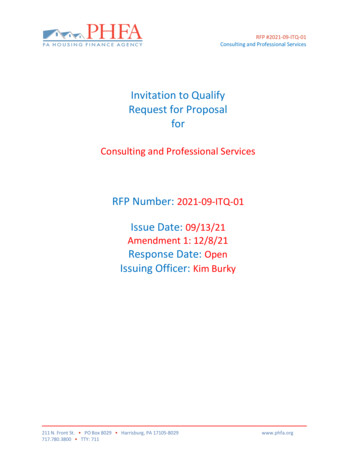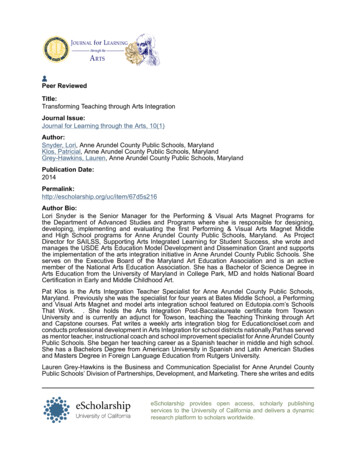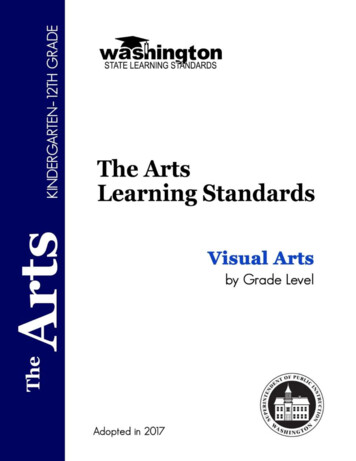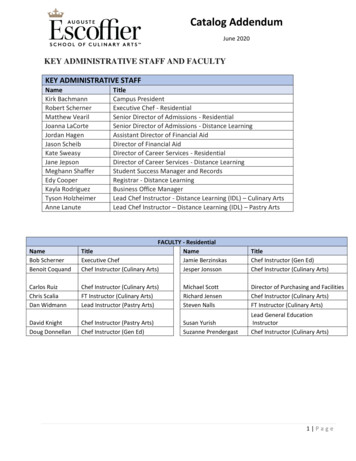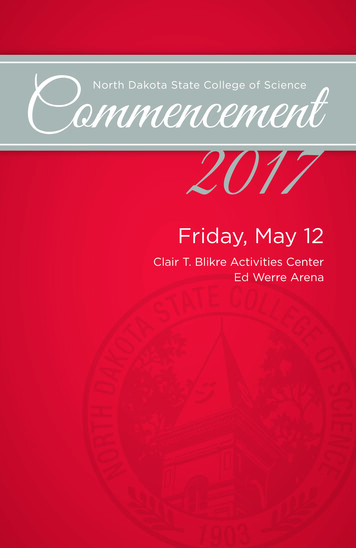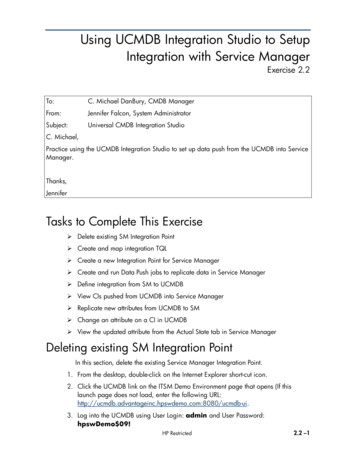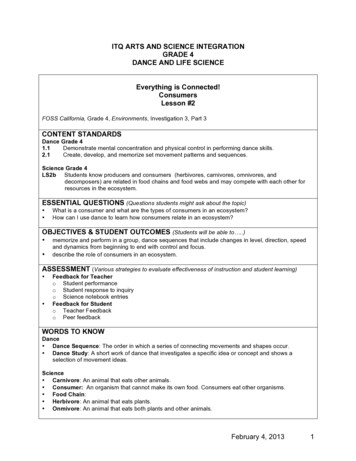
Transcription
ITQ ARTS AND SCIENCE INTEGRATIONGRADE 4DANCE AND LIFE SCIENCEEverything is Connected!ConsumersLesson #2FOSS California, Grade 4, Environments, Investigation 3, Part 3CONTENT STANDARDSDance Grade 41.1Demonstrate mental concentration and physical control in performing dance skills.2.1Create, develop, and memorize set movement patterns and sequences.Science Grade 4LS2b Students know producers and consumers (herbivores, carnivores, omnivores, anddecomposers) are related in food chains and food webs and may compete with each other forresources in the ecosystem.ESSENTIAL QUESTIONS (Questions students might ask about the topic) What is a consumer and what are the types of consumers in an ecosystem?How can I use dance to learn how consumers relate in an ecosystem?OBJECTIVES & STUDENT OUTCOMES (Students will be able to .) memorize and perform in a group, dance sequences that include changes in level, direction, speedand dynamics from beginning to end with control and focus.describe the role of consumers in an ecosystem.ASSESSMENT (Various strategies to evaluate effectiveness of instruction and student learning) Feedback for Teachero Student performanceo Student response to inquiryo Science notebook entriesFeedback for Studento Teacher Feedbacko Peer feedbackWORDS TO KNOWDance Dance Sequence: The order in which a series of connecting movements and shapes occur. Dance Study: A short work of dance that investigates a specific idea or concept and shows aselection of movement ideas.Science Carnivore: An animal that eats other animals. Consumer: An organism that cannot make its own food. Consumers eat other organisms. Food Chain: Herbivore: An animal that eats plants. Onmivore: An animal that eats both plants and other animals.February 4, 20131
MATERIALS CD Player and musicFood Pyramid Chart (from lesson #1) and markersDiagram #1, Chart of Rap #3 and Rap #4 for overheadPictures of herbivores (diagram #2), carnivores (diagram #3), and omnivores (diagram #4)“Food Chain Rap and Dance Study” (diagram #5)“Performance Rubric” (diagram #6)Computer with access to youtubeCD Player and musicScience notebooks (1/student)RESOURCES FOSS California, Grade 4, Environments, Investigation 3, Part 3List of herbivorous animals: http://en.wikipedia.org/wiki/List of herbivorous animalsFood Chain: Kids’ ology: facts.cfmYou’re an Omnivore Song: http://www.youtube.com/watch?v YVh2fGI9Jgo&feature relatedFlocabulary: http://flocabulary.com/ecosystems/ (you must become a member to use this site) contentis included at the end of this lesson.Slide Step: www.youtube.com/watch?v mK rsgrgAKkPREPARATION Teach FOSS California, Grade 4, Environments, Investigation 3, Part 3A chart of the Food Pyramid (from lesson #1).Optional: 10 copies of the Rap 3 sheet (diagram #1)Frontload:o Have students read the rap text several times prior to teaching this lesson. It is recommendedthat students spend about five minutes for three or more days to become acquainted with thewords. If you can teach the rhythm and students can speak the lines in rhythm, they will be betterprepared for the dance portion of this lesson.WARM UP (Engage students, access prior learning, review, hook or activity to focus the student forlearning)(10 minutes) Review Raps 1 and 2 from lesson 1 with dance sequences. Review ecosystem and producer.MODELING (Presentation of new material, demonstration of the process, direct instruction)(20 minutes) Ask: What is a consumer? [Think, pair share and report answers]. Say:o Organisms that eat other organisms are called consumers. Insects such as grasshoppers andsnails eat plants that have stored energy in the form of sugar, which in turn gives them energy.Animals such as deer, rabbits and cows also eat and get energy from plants. Consumers suchas these are called herbivores. (Explain to students the compound word: “herbi” means plantand “vore” means one that eats.). Herbivores eat only plants. (Refer to Diagram #2 Types ofConsumers)o Animals, like lions, crocodiles, sharks, hawks, eagles, owls, and snakes eat other animals to gettheir energy. They are called carnivores (meaning meat eaters). (Refer to Diagram #3 Types ofCarnivores)o Animals that eat both plants and animals are called omnivores (omni meaning all). Examples ofthese animals are humans (people), pigs, bears, chipmunks, rats, raccoons, and chimpanzees.February 4, 20132
(Refer to Diagram #4 Types of Consumers-The Omnivores)oDraw another line on the Food Chain chart and label it consumers.Say: Today, we will learn dance sequences #3 and 4; all about consumers. This will be part two ofour dance study.Teach Rap #3 rhythm:o Say (and students repeat): Consumers depend on producers for food. They’ll even eat eachother for their dinner, dude! Herbivores, carnivores, and omnivores, too. Consumers eatorganisms for food.Ø The Consumers Step (cha-cha step). Start with the right foot. Step forward with the right foot, rock back on the left, step backwith the right, step left, step right in place. (Cue: forward, back, cha, cha, cha, or countone, two, three and four). Arms move in opposition and are held loosely throughout. Repeat on the left (step forward with the left, back on the right, step left-right-left in place),beats five through eight. On the word “dude” students will raise up their arms, palms up. Repeat two more times for a total of 32 beats. On the word “dude” the hands are placed inthe air.GUIDED PRACTICE (Application of knowledge, problem solving, corrective feedback)(15 minutes) Arrange students in smaller groups of even numbers (six or eight). Post Rap #3 on the overhead or distribute a copy to each group. Have raps #1 and 2 ready to post for the last five minutes of this section. Post “Food Chain Rap and Dance Study” (diagram #5) or provide handouts per group. This will helpstudents remember both the rap and the movement. Say: You will be rehearsing in small groups. Practice each line of the first rap, one at a time, until youare able say the rap and perform the steps at the same time. When you feel comfortable with the thirdrap, try and add it to raps one and two. I will give you 10 minutes to work on the third rap then I willstop and check to see how you are doing. You will then have another five minutes to work on puttingthe three raps together. (Post raps 1 and 2 the last five minutes of guided practice). Move from group to group checking on progress. Take notes on which students seem to prefer,moving or rapping. This will be significant information for lesson three. Option: Divide the class in half. One half of the group will rap and the other half will dance. Switchgroups and repeat.DEBRIEF & REFLECT (Identify problems encountered, ask and answer questions, discuss solutionsand learning that took place. Did students meet outcomes?)(5 minutes) Record answers in your science notebooks to the following prompts:o What are consumers?o What are the three types of consumers?o What role do producers and consumers play in an ecosystem?o Have students work in pairs or small groups to recall the words and dance steps for rap 3. Haveeach student make notes of the dance steps that correspond to the rap. Refer to Diagram #3:Food Chain Rap and Dance Study in lesson #1.o How did the rap and dance steps help you to understand the role of producers and consumers inan ecosystem?EXTENSION (Expectations created by the teacher that encourage students to participate in furtherresearch, make connections, and apply understanding and skills previously learned to personalexperiences.) Allow students to rehearse raps 1, 2, and 3 throughout the week until they are memorized. Introduce rap 4 so that students are prepared to begin rapping and dancing in lesson #3.February 4, 20133
Continue to take notes on which students perform the rap or dance best. Begin to assign a differentrapper and dancers for rap.Show videotape to students and ask them to observe and make corrections. Use diagram #6 toprepare students for performance.February 4, 20134
DIAGRAM #1RAP #3Consumers depend on producers for food.They’ll even eat each other for their dinner,dude!Herbivores, carnivores, and omnivores, too.Consumers eat organisms for food.February 4, 20135
Diagram #2 - TYPES OF CONSUMERSTHE HERBIVORESgrasshopperdeersnailrabbitcowFebruary 4, 20136
Diagram #3 - TYPES OF CONSUMERSTHE ary 4, 20137
Diagram #4 - TYPES OF CONSUMERSTHE babboonFebruary 4, 20138
Diagram #5Food Chain Rap and Dance StudyRap #1234Rap WordsSmall as a puddle or large as the sea,living and non-living thrive in harmony.Dance SequenceThe Thrive/Ecosystem Step(down, up, isolate ribs) – 16beatsAnimals, plankton, water, soil, air.Ecosystems are everywhere!Repeat 16 beatsWhat do producers need to make their own food?Sunlight, water and CO2.The Producer’s step (step to theside, cross behind) – 16 beatsAlgae, grass, plants and vegetables, too.Producers make, make their own food.Repeat 16 beatsConsumers depend on producers for food.They’ll even eat each other for their dinner, dude!The Consumers Step (stepforward, back, cha-cha-cha) - 16beatsHerbivores, carnivores, and omnivores, too.Consumers eat organisms for food.Repeat 16 beatsDead animals and plants disappear in the groundfrom microscopic organisms breaking them down.Decomposers Step (the CatDaddy) – 16 beatsDecomposing matter’s nutrients are good for the soil.Nothing is wasted. Decomposers are loyal.Repeat 16 beatsFungi, bacteria, and earthworms too.Decomposers really benefit you.Move to ending group shape –16 beatsYeah!FreezeFebruary 4, 20139
Diagram #6 - PerformanceRubric4 – The rap is clearly understood (rhythm, volume and articulation) and the dance sequences are clearand correctly executed. Both the words and the dance sequences are memorized and performed withouthesitation. Students need no coaching from the teacher. The group cooperates well together. The danceclearly shows an introduction to the next part of the dance study (groups 1-3), or a frozen shape (group 4)to end the dance study. Students may add “beat box” or other rhythmic sounds.3 – The rap is understood (volume and articulation) and the dance sequences are recognizably executed.The rap and dance sequences are mostly memorized and may show some hesitation. Students mightneed to stop, discuss briefly or receive prompting from the teacher as to dance sequence, rhythm of therap, or coordination. The group cooperates well together. The dance clearly shows an introduction to thenext part of the dance study (groups 1-3), or a frozen shape (group 4) to end the dance study.2 – The rap is mostly understood (volume and articulation) and the dance sequences are identifiable.Students have some difficulty with memorization and may hesitate several times or may even stop andstart over. Not all members of the group are fully engaged. The dance does not show a clear introductionor frozen shape.1 – The rap is not understood and the dance sequences are roughly executed. Vocals and movement issloppy. The rapper and dancers have difficulty getting through the rap without coaching or stopping andstarting. Students do not work well as a team. The dance has no clear ending.Rap meRhythmMemorization#4Names:#1Names:Correct placementRhythmCorrect placementRhythmCorrect placementRhythmCorrect ionLeadershipEncouragement4321February 4, 201310
Post “Food Chain Rap and Dance Study” (diagram #5) or provide handouts per group. This will help students remember both the rap and the movement. Say: You will be rehearsing in small groups. Practice each line of the first rap, one at a time, until you are able say the
